Eye safety
Dangers of viewing of the Sun
People are generally aware that it is not safe to stare at the Sun. Humans have an automatic response to look away or close their eyes when attempting to observe the Sun. This is a natural process that helps to protect our eyesight. When they know an eclipse is taking place, people, especially children, have a natural curiosity and may be tempted to try to look. Children can be less aware than adults of the dangers of staring at the Sun. This is exacerbated when there is a deep partial eclipse, and the Sun is reduced to a thin crescent as the “look away” response may be reduced. The message that viewing of the Sun without proper precautions at any time is dangerous needs to be reinforced, especially for young children and supervision is required at these times.
The primary concern over unprotected viewing of the Sun during an eclipse (or at any other time) is the development of “eclipse blindness” or retinal burns. Exposure of the retina to intense visible light causes damage to its light-sensitive rod and cone cells. The light triggers a series of complex chemical reactions within the cells that damage their ability to function and in extreme cases, can destroy them. The result is a loss of vision, which may be either temporary or permanent depending on the severity of the damage.
In addition, the high level of visible and near-infrared radiation can cause heating that literally cooks the exposed tissue. This thermal injury or photocoagulation destroys the rods and cones, creating a blind spot burned into the retina.
There are two effects which compound the danger. Firstly, the injuries occur without any feeling of pain (the retina has no pain receptors) and secondly, the visual effects may not become apparent for at least several hours after the damage is done. For these reasons, significant damage may occur without the victim being aware of it.
Because optical instruments intensify the light, looking at the Sun through an unfiltered telescope or binoculars is extremely dangerous as it can cause permanent damage almost immediately.
It is never safe to look directly at a partial solar eclipse or annular solar eclipse or the partial phases of a total solar eclipse without the proper equipment and techniques. Even when 99% of the Sun’s surface (the photosphere) is obscured during the partial phases of a solar eclipse, the remaining crescent Sun is still intense enough to cause a retinal burn, even though illumination levels may be comparable to twilight. Failure to use proper observing methods may result in permanent eye damage and severe visual loss.
During a partial solar eclipse such as the one which will occur over the whole of Australia on 20 April 2023 and the four other eclipses to follow (or at any other time), it is very dangerous to look directly at the Sun without using a special purpose solar filter or using indirect methods such as are described below.
Safe viewing of the partial eclipse
The only safe way to look directly at the partially eclipsed Sun or the Sun at any other time is through special-purpose solar filters, such as “eclipse glasses” or handheld solar viewers. See examples in figure 1. However, it is vital that they conform to the correct standard, and they are used safely.
Here are tips to assist in the safe uses of eclipse glasses and similar products:
- The filters must be certified to comply with the requirements of the ISO 12312-2 international standard. It is strongly recommended that they be purchased from reputable vendors to ensure that they have been correctly certified. These may include astronomy supply shops, public observatories and planetariums or from a government agency. Ordering from other suppliers especially on the internet is not recommended as the filters may not be correctly certified.
- Always inspect your solar filter before use; if scratched, punctured, torn, or otherwise damaged, discard it. Read and follow any instructions printed on or packaged with the filter.
- Always supervise children (or others who need supervision) using solar filters, ensuring that they use them correctly and do not sneak a peek at the Sun around the filter.
- If you normally wear eyeglasses for distance vision, keep them on. Put your eclipse glasses on over them or hold your handheld viewer in front of them.
- Stand still and cover your eyes with your eclipse glasses or solar viewer before looking up at the bright Sun. After looking at the Sun, turn away and remove your filter - do not remove it while looking at the Sun.
- Do not look at the uneclipsed, or partially eclipsed Sun through an unfiltered camera, telescope, binoculars, or other optical device.
- Similarly, do not look at the Sun through a camera, telescope, binoculars, or any other optical device while using your eclipse glasses or handheld solar viewer - the concentrated solar rays could damage the filter and enter your eye(s), causing serious injury.
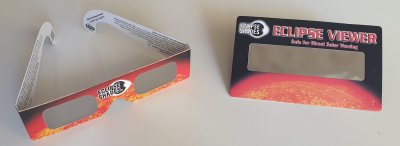
How to view totality safely
It is safe, and awe-inspiring, to watch the eclipse without eye protection during the brief period called totality, while the Moon is completely covering the Sun – that is the excitement of this event! However, you must be sure that you are watching at the correct time and place and are in totality. Refer to the maps and times shown in the pages for the five Australian eclipses to check where to be and when. If you are inside the path of totality, remove your solar filter only when the Moon completely covers the Sun’s bright face, and it suddenly gets quite dark. Wait until the last bright spots around the edge of the Sun as viewed through your filter have disappeared.
Experience totality, then, as soon as the bright Sun begins to reappear in the “diamond ring”, look away or replace your solar viewer to look at the remaining partial phases. It should be noted that certified “eclipse glasses” and filters are intended to be used for the partial phases of the eclipse. They MUST be removed to experience totality. If using the pinhole method to watch the progress of the eclipse, be aware that it cannot be used to determine the start of totality as the image will fade out well before the start of totality and viewing with a properly certified solar filter is a more effective method.
Projection method of viewing the Sun
Projection methods are inherently safe because no one is looking directly at the Sun, but caution is still required.
Pinhole projection
A relatively safe and inexpensive method of observing the Sun during a partial solar eclipse is to view an image of it formed by “pinhole projection”. Use two pieces of card or paper, one with a 2 mm hole in it. Stand facing away from the Sun and project an image of the Sun through the hole in the card onto the other card. Do NOT look at the Sun through the hole in the card. You will need to hold the cards about a meter apart and although it will produce a small image of the Sun (less than 10 mm across) if there is enough coverage of the Sun by the Moon you should see the “bite” taken out of the Sun. Because the image is small and faint some may find this method frustrating to use.
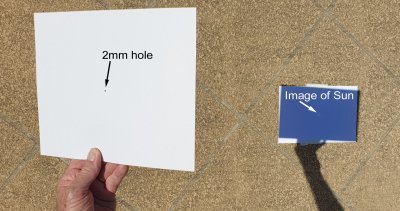
An interesting modification of this is to make a series of holes in the card in a pattern or making words spelling out the date, the place you are at or your name etc. This will make multiple crescent shapes and can make a memorable photo record of the eclipse.
Also, during a partial solar eclipse, multiple openings in pegboard, in a loosely woven straw hat, or a kitchen colander can project multiple images. If you do not have a card or anything else available, cross the outstretched, slightly open fingers of one hand over the outstretched, slightly open fingers of the other. With your back to the Sun, look at the shadow of your hands on the ground or an adjacent wall. The little spaces between your fingers will project a grid of small crescent shaped images.
A good place to look for crescent eclipse images is under leafy trees, the taller the better, where the “pinholes” formed by overlapping leaves create many crescent images on the ground or an adjacent wall. See the section on what happens during a partial solar eclipse for photos of these effects.
Mirror projection
A method of projection that is useful for demonstrating to a group is to use a small flat mirror. A circular mirror is best and can be made by adding a cardboard circular mask or black tape to the front of a handheld mirror so that only a small circle of the mirror is showing. A 20 mm diameter circle is suitable. Point the mirror in the direction of the Sun and aim the reflection of the Sun onto a white wall or screen in the shade. This will show an image of the Sun revealing its crescent shape. The image will be about 9 centimetres in diameter at a distance of 10 metres or about 18 centimetres in diameter at about 20 metres. To the person holding the mirror, the angular size of the image will be the same as the apparent size of the Sun in the sky. It is useful to have a method of holding the mirror in place. The Sun’s image will not have sharp edges and this method is not suitable for viewing sunspots. The image can be made brighter by increasing the diameter of the mirror circle, but this will also make it appear less sharp. The method is substantially enhanced if the mirror’s reflection can be directed in through an open window into an otherwise darkened room. This method can be adapted (with suitable risk management) to a classroom environment or outdoor shaded area to demonstrate to students or other groups that an eclipse is in progress without the participants having to be outside or in the Sun. Conveniently, this method can be prepared and practised before eclipse day. It is important that no one looks at the reflection of the Sun in the mirror and care must be taken not to shine the reflected Sun into anyone’s eyes. Figure 3 shows an image of the Sun reflected from a mirror with a 20 mm mask onto a white screen at a distance of 10 metres.
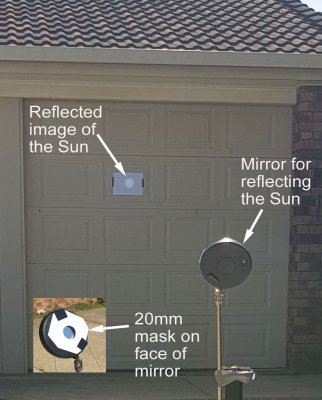
Binocular or Telescope projection
With appropriate safety precautions, binoculars or a small telescope mounted on a tripod can also be used to project a magnified image of the Sun onto a white card. This can show not only partial eclipse phases but can also show sunspots on the Sun.
Cover both the front and rear lenses of one side of a pair of binoculars. Attach the binoculars to a tripod and aim the binoculars at the Sun by minimising the shadow of the binoculars. Do NOT look through the binoculars to find the Sun. Arrange a white card about 30 - 50 centimetres behind the binoculars so that the Sun’s image falls on the card. Use the focus knob on the binoculars to sharpen the image. Use a piece of cardboard with two holes cut in it to fit snugly over the front lenses of the binoculars to make the Sun’s image more visible as it will be surrounded by shade. The crescent shape of the eclipsed Sun can be seen easily as well as any large sunspots.
Figure 4 is an example of how this can be done. Do not place any object or body part between the binoculars and white card otherwise there is a danger of burns. This method of viewing the Sun should only be used for short periods to avoid excessive heat build-up in the binoculars. To take a break, simply cover the lens at the front end of the binoculars.
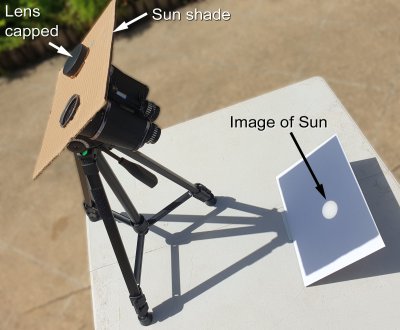
Telescope projection can be done in a similar way to binocular projection. Use a small telescope (or “stop down” a larger telescope) otherwise the heat in the telescope could damage the telescope eyepiece and other components. Remove or otherwise securely block off any finder scope or similar device on the telescope. Arrange a screen to project the image of the Sun from the eyepiece of the telescope and focus the image. Some telescopes come provided with a screen to project images on, otherwise it will be necessary to improvise one. This method of viewing the Sun should also only be used for short periods to avoid excessive heat build-up in the telescope components.
Binocular and telescope projection are methods of indirectly viewing the Sun. This has the advantage that no one is looking at the Sun. Observers only view the projected image of the Sun. However, it is essential that safety precautions be adopted to ensure that no one attempts to look through the binoculars or telescope at the Sun as this can cause immediate and serious damage to eyesight. It is essential that someone remains responsible for the setup and the binoculars or telescope are never left unattended.
An interesting variation of telescope projection is to use a “Sun funnel” where the beam of sunlight between the telescope eyepiece and the screen is enclosed so making the arrangement safer. Details can be found on [Link] https://eclipse.aas.org/eye-safety/projection. This method should only be used by knowledgeable amateur and professional astronomers who know how to operate a telescope for solar observing.
Commercial projection devices
Commercially manufactured solar projection devices are available. Two such examples are the “Solarscope” and the “Sun Spotter”. Both incorporate a lens and a folded light path to produce an image of the Sun on a screen. Used properly, they are inherently safe and can be easily setup and aligned and are well suited to the education environment where they can be used by a number of students together. Their optics are good enough to see sunspots on the Sun. See figures 5 and 6 and the web Links below.
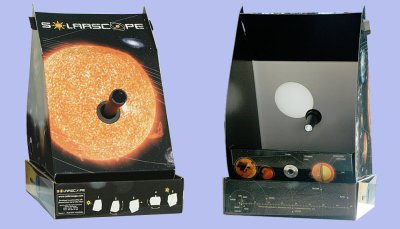
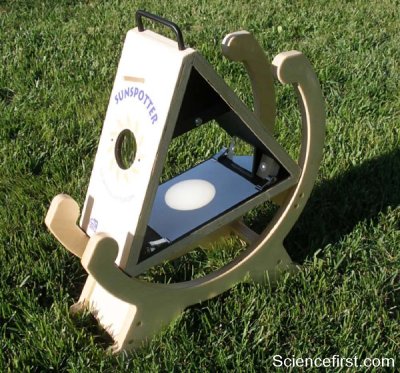
Specialised Solar Telescopes and Telescope Filters
Astronomy supply shops sell specialised telescopes equipped with Hydrogen Alpha filters for observing and photographing the chromosphere of the Sun and solar prominences. These are expensive devices. Also available is specialised filter materials that can be used with telescopes and cameras. These items should only be used by knowledgeable amateur and professional astronomers who know how to operate a telescope for solar observing and solar photography. More information is in Eclipse Photography.
Organised Safe Observing sessions
Another good way to observe the eclipse safely is to contact your local planetarium or observatory or local amateur astronomical society who may organise an eclipse viewing session. See the web Links below.
Safe solar viewing as an extension of regular Sun safe messages
The potential for skin damage from harmful rays of the Sun are well known. Australian authorities promote Sun safety strategies to protect citizens and especially children from the dangers of over-exposure to the Sun, for example by minimising exposure times, encouraging the use of protective clothing and the use of broad-spectrum sunscreen. The wearing of sunglasses is normally encouraged to guard against long term UV damage to eyesight. Messages of protecting eyesight from inappropriate viewing of the Sun and how to observe the Sun safely during an eclipse or transit are natural complements to these initiatives.
Eclipse Eye Safety websites
- NASA Eye Safety during a Solar Eclipse https://solarsystem.nasa.gov/eclipses/safety/
- American Astronomical Society How to View a Solar Eclipse Safely https://eclipse.aas.org/eye-safety
- Australian Observatories and Planetariums: https://astronomy.org.au/education/observatories-planetaria/
- Detailed explanation and analysis of solar eclipse eye safety by the recognised world expert Ralph Chou: https://eclipse.aas.org/sites/eclipse.aas.org/files/Chou-Solar-Eclipse-Eye-Safety-AAS-2016.pdf.
- Australian amateur astronomical societies and clubs: https://astronomy.org.au/amateur/amateur-societies/australia/
- Solarscope solar image projection device: http://www.solarscope.com/en/index.en.html
- Sun Spotter solar image projection device: Online search will reveal several vendors.
- International Astronomical Union eclipse eye safety: http://web.williams.edu/Astronomy/IAU_eclipses/
